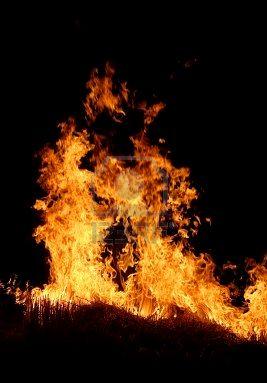The Mystery of Hanno’s Fiery Streams August 12, 2010
Author: Beach Combing | in : Ancient , trackback Regular readers will know that Beachcombing has visited the Voyage of Hanno before and that this text, written in Hellenistic Greek, purports to describe a Carthaginian expedition down the western coast of Africa in the early centuries B.C., in an age when good Mediterranean folk had as little to do with the sub-Saharan side of the continent as possible. Last time Beachcombing looked at the mystery of the ‘gorillas’ that Hanno’s men captured. Today, instead, he wants to turn to the equally pressing question of Hanno’s experience with African fires.
Regular readers will know that Beachcombing has visited the Voyage of Hanno before and that this text, written in Hellenistic Greek, purports to describe a Carthaginian expedition down the western coast of Africa in the early centuries B.C., in an age when good Mediterranean folk had as little to do with the sub-Saharan side of the continent as possible. Last time Beachcombing looked at the mystery of the ‘gorillas’ that Hanno’s men captured. Today, instead, he wants to turn to the equally pressing question of Hanno’s experience with African fires.
Beachcombing quotes here from about half way through the surviving text as Hanno and his sixty boats moves down past the island of Cerne (probably on the Moroccan Coast). Fiery passages have been underlined.
From Cerne we sailed towards the south for twelve days, skirting the coast. This was peopled all the way be Ethiopians [i.e. Black Africans], who would not stand their ground, but ran away from us. Their tongue was unintelligible… On the last day [of the twelve] we approached and made fast under a high wooded range, the trees of which were fragrant and of divers colours. Here we doubled this point in two day’s sail in an immense recess of sea, on the side of which was flat stretch extending to the coast. Here we saw fires blazing up by night at intervals in all directions, some greater, some less. Here we took in water and sailed on for five days, hugging the land, until we came to great gulf which our interpreters informed us was called the Western Horn. In this was a large island, and in the island was a saltwater lake, and in this another island, where, when we had landed, we could in the daytime see nothing but forest; but by night we saw many fires burning and heard the sound of pipes and cymbals and the rattle of drums and the noise of a great multitude. Terror seized us and our soothsayers bade us quit the island. Sailing thence in haste we coasted along a country all ablaze with flames that sent forth an aromatic smell, from which streams of fire poured down into the sea. And the land was unapproachable for the heat. Quickly we sailed away from there in terror; and, in four days’ run, saw the land by night all ablaze. In the centre was a leaping flame, towering above the rest, which seemed to reach the stars. When day came, it was called the Chariot of the Gods. On the third day after our departure thence, after sailing past those streams of fire, we reached a gulf called the Southern Horn.
What is the night fire referred to here? Beachcombing has come across various explanations. One is local custom. Mungo Park travelling in Africa in the late eighteenth century reported in Travels in the Interior of Africa the burning away of old vegetation: ‘The Burning of the grass exhibits a scene of terrific grandeur. In the middle of the night I could see the plains and mountains, as far as my eye could reach, variegated with lines of fire; and the light reflected on the sky made the heavens appear ablaze.’
Another explanation would be volcanic activity – though that doesn’t sit very well with the drums and kpanlogos.
Of course, not all the fires necessarily had the same origin
The Chariot of the Gods meanwhile – Beachcombing thanks the ancient astronauts that Erik Von Daniken didn’t hear about that… – has been identified with several mountains on the western coast of Africa including Mount Cameroon (Cameroon) and Kakulima (Guinea) – the difference between these two should give some sense of how difficult it is to pin Hanno’s description down.
Perhaps, as Beachcombing hinted in his last post, what Hanno’s account represents is not a single journey, but rather a melange of different Punic travel stories from the region. In that case the fire might be the experience of Mediterranean sailors confronted with night time ceremonies on the Dark Continent, gelling with Mediterranean beliefs that the equatorial parts of the earth were fiery hot. Perhaps, perhaps, perhaps…
Beachcombing would love to hear of any other explanations. Drbeachcombing AT yahoo DOT com


